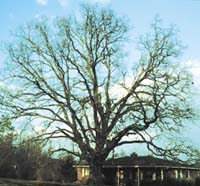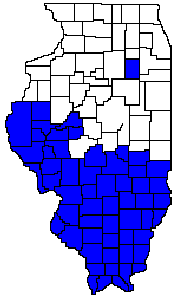 |
| Post
Oak (Quercus stellata)
Distribution
Map to Right |

Post oak is a small to large tree, depending upon the situation in which it is growing. Typically, post oak has a scrubby growth form because it grows on dry, sandy or gravelly, nutrient-poor sites. It grows in barrens, savannas, flatwoods, and in dry and xeric upland forests, often on bluffs. Under these conditions, it is often a small to medium-sized tree. It can reach a height of up to 60 feet when the site has better growing conditions. Its trunk can reach a diameter of up to 3 feet, but is usually less.
Interesting
Facts
Post
oak is frequently identified by its cross-shaped leaves. Though the lobes
of the leaves are often so, they vary in shape by population and region,
and the characteristic is therefore not a reliable one for purposes of
identification. The thick, yellowish twigs and the yellow, star-shaped
(stella means star) hairs on the underside of the leaf are better
identifying features. The common name, post oak, comes from the fact that
the wood is used for fence posts.
Identifying Features
BarkUses
The bark is gray or light brown, with deep grooves and broad ridges. In older trees, the grooves/ridges appear to twist slightly down the length of the trunk. Its branches are thick and spreading, forming a rounded, broad crown. Sometimes, the branches are contorted. Post oak is a very slow-growing tree, but one that can live to be 500 years old.
Leaves
The leaves of post oak are alternate and simple. They are from 4 to 6 inches in length and from 2 to 4 inches broad. They usually have 5 rather squarish or rounded lobes, which are smaller at the base of the leaf and become broader near the tip. The middle pair of lobes is often at almost right angles to the midrib of the leaf, giving it a cross-shaped appearance. The surface of the leaf is dark green and has scattered stiff hairs, giving it a rough texture. The leaf is stiff and hard, with a shiny, waxy coating. The underside of the leaf has yellowish hairs on it, as do the twigs.
Flowers
The flowers are typical of oaks. The male and female flowers are on the same tree, but separate, and they appear just as the leaves begin to unfold. Male flowers are drooping yellow catkins. The female flowers are red and borne as a few per cluster.
Fruits
The acorns are from 1/2 to 1 inch long and occur either singly or in pairs. The cup is reddish brown and covers approximately 1/3 of the nut. Its scales are slightly hairy.
The wood is close grained and hard, and does not rot quickly in the soil. It was also used for rough construction and fuel. Native Americans consumed acorns from a variety of oaks, most likely including the post oak. They used post oak medicinally to treat a number of illnesses, ranging from skin infections and canker sores, to fevers and dysentery.